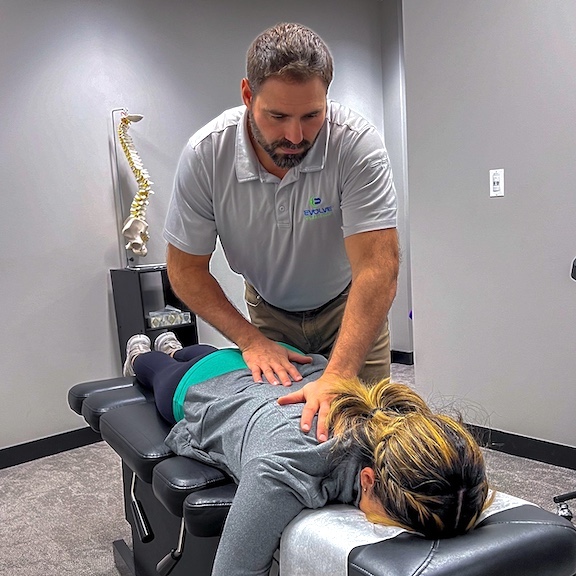Asthma is a chronic illness affecting millions of adults and children globally. For many families, asthma management is a balancing act of daily medication schedules, trigger avoidance, and watching for signs of flare-ups. Faced with these challenges, it’s natural for individuals to wonder whether complementary treatment options, like chiropractic care, might provide some asthma relief.
Let’s be very clear here: chiropractic care doesn’t “cure” asthma. However, many patients find that chiropractic adjustment can support easier breathing, reduce the incidence of flare-ups, and improve their quality of life overall.
By focusing on spinal manipulation and alignment, nervous system balance, and posture, chiropractic care is a great complementary approach for those who want to explore alternative or holistic solutions to improve their respiratory function.
Understanding Asthma and Its Impact
When you have chronic asthma, your airways become inflamed and narrowed, often producing excess mucus. This eventually leads to hallmark asthma symptoms, including:
- Wheezing
- Shortness of breath
- Tightness in the chest
- Excessive coughing
Asthma attacks are often triggered by a myriad of factors, ranging from allergens and exercise to stress and cold air. Respiratory infections can also trigger attacks. In the case of children, chronic pediatric asthma flare-ups can lead to disrupted sleep, reductions in physical activity, and anxiety around everyday play. And adults with asthma often deal with issues like lost productivity, tiredness, and concerns about trigger exposure.
How Chiropractic Care May Support Asthma Management
So, how exactly does chiropractic care support good asthma management? The answer lies in the tenets of chiropractic care. At its core is the long-standing belief that spinal alignment has a direct influence on how the nervous system functions. And the nervous system is responsible for regulating every organ – lungs and diaphragm included.
Whenever the spine is misaligned (called subluxation), the nerves connected to the respiratory system become irritated. Such interference can limit the body’s ability to coordinate efficient breathing.
Through chiropractic adjustments, chiropractors seek to restore misalignments, allowing the nervous system to communicate more effectively with the lungs and diaphragm.
After chiropractic sessions, many patients feel like their lung capacity has increased and that they can breathe more smoothly. Although results vary by person, this focus on nervous system balance helps to provide a more favorable internal environment, one where the body is able to function closer to its optimal state.
Posture and Breathing Efficiency
Your posture plays an important role in asthma management.
Unfortunately, technological innovations and screen-filled days lead to a forward head posture and rounded shoulders. This causes the chest cavity to become compressed, restricting rib movement and diaphragmatic breathing. For asthma patients, these restrictions can make existing symptoms worse and increase the intensity of flare-ups.
Through chiropractic adjustments, mobility work, and posture correction, you can expand your chest cavity and boost lung capacity. The result is easier, more efficient breathing. Improved posture not only supports breathing but also increases your energy stores and overall comfort as you move through your daily life.
Stress, the Nervous System, and Asthma
Of all asthma attack triggers, stress is among the most common and overlooked. Whenever your body is under stress, your nervous system switches from “rest and digest” mode to “fight or flight” mode. When you’re in the latter mode, conditions may be favorable for inflammation and muscle tension, both of which can worsen your breathing difficulties.
Chiropractic care is a supportive measure for the parasympathetic nervous system (the “rest and digest” response). When you encourage your body to go into this state with chiropractic adjustments, you can experience lower stress levels, reduce tension in the body, and create an internal environment that’s less prone to asthma flare-ups. For both children and adults, this calming effect may be a welcome addition to traditional asthma care.
What Research Says About Chiropractic and Asthma
Research on the link between chiropractic care and asthma is not very clearly established, but it is developing. There are studies that suggest that regular chiropractic adjustments can boost the quality of life for asthma sufferers, reducing their symptoms. Physiological therapeutics is also recognized to improve lung function perception.
Larger-scale, definitive vertebral subluxation research studies are needed to cement chiropractic care as a standalone asthma treatment.
As things stand now, chiropractic care is accepted as a complementary therapy. Therefore, patients should take the medications they’ve been prescribed and continue seeing their medical provider. It’s best to utilize chiropractic care as an additional tool to support overall wellness and breathing function.
Note: Keep an eye on chiropractic news outlets for new developments on asthma research and the benefits of chiropractic care. Science is always progressing.
Additional Ways Chiropractors Support Asthma Patients
Contrary to popular belief, chiropractic care isn’t just about spinal adjustments. Chiropractic professionals utilize a variety of strategies to support patients living with asthma. They include:
- Breathing exercises meant to foster deeper lung expansion.
- Posture education to help patients achieve and maintain open chest positioning as they go about their days.
- Stretching routines to enhance chest mobility and loosen up tight muscles.
- Lifestyle recommendations to avoid or minimize exposure to asthma triggers like allergens or stressors.
- Nutritional or wellness advice for better immune system health; this is particularly valuable since respiratory infections can cause asthma attacks.
Beyond medication, these measures allow patients to take proactive steps to reduce asthma severity and facilitate effective management of the condition.
Breathing Better with Chiropractic Care
No, chiropractic treatment doesn’t cure asthma. The condition is ongoing and requires constant management from a medical professional. However, chiropractic treatment can help patients breathe easier, reduce their stress levels, and live better lives.
Whether you have asthma or are the parent of a child with the condition, chiropractic offers a natural and non-invasive way to complement your traditional asthma care. When you and your chiropractor work on spinal alignment, posture, and stress reduction, you could see very real results.
If you or your child struggles with asthma, exploring chiropractic care as part of a holistic management plan could be the way to go. Having a consultation with a licensed chiropractor can help you determine if this approach is the right fit for your family.





